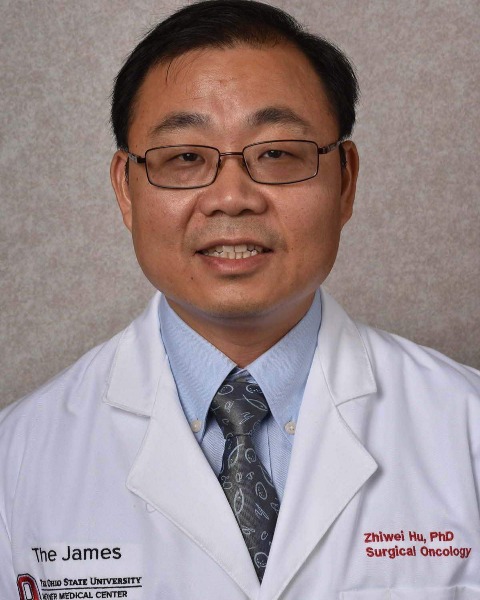
Zhiwei Hu, MD, MSc, PhD (he/him/his)
Associate Professor
The Ohio State University
Dr. Zhiwei Hu is an associate professor and a member of the Translational Therapeutics Program at OSUCCC – James, where his research focuses on identifying novel targets and developing corresponding targeted therapies for solid cancers, hematological malignancies, and other unmet noncancerous diseases. He has 28+ years of experience in tumor immunology, neovascular-, cancer stem cell- and cancer cell-targeting immunotherapy (such as monoclonal antibody, phage display antibody, antibody engineering, chimeric antigen receptor modified natural killer cells, i.e., CAR-NK), gene therapy, and photodynamic therapy (PDT). Dr. Hu has a track record of invention of novel targeted therapeutic agents (filed through Yale University and The Ohio State University, OSU). While at Yale (1998-2012), he co-invented the first tissue factor (TF)-targeting antibody-like agent, called ICON, for the treatment of cancers. As a neovascular-targeting agent, ICON has shown efficacy and safety in preclinical studies for treating angiogenesis-dependent diseases, notably cancer, age-related macular degeneration (AMD), and endometriosis, as well as in early phase clinical trials for patients with melanoma and AMD. In 2010, Dr. Hu co-developed TF-targeted PDT for cancer and AMD at Yale. After moving to OSU, Dr. Hu invented the second and third generations of TF-targeting ICONs (called L-ICON1 and L-ICON3, for light chain ICONs). In addition, Hu lab reported, for the first time, that TF is a novel target for cancer stem cells and that TF is a novel target in patients with triple-negative breast cancer (TNBC). Using the CAR approach, Hu lab invented a new line of TF-targeted CAR-NK cell (patent pending, OSU) that are effective and safe as monotherapy for treatment of TNBC and multiple myeloma. Dr. Hu’s long-term research goal is to translate novel targeted therapies into the clinic for treatment of pathological angiogenesis-dependent diseases (notably cancer, AMD, and endometriosis) and macrophage-associated diseases (notably atherosclerosis, HIV, and Ebola viral infections).
Poster(s):
-
Thursday, September 28, 202312:30 PM - 1:30 PM EEST
